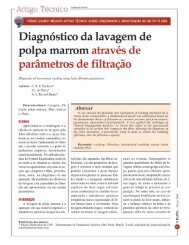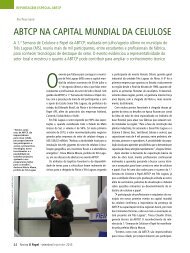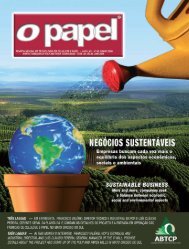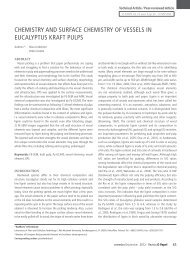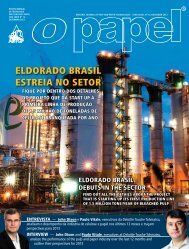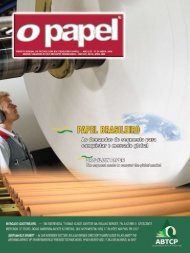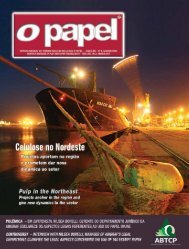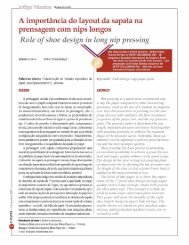international article - Revista O Papel
international article - Revista O Papel
international article - Revista O Papel
You also want an ePaper? Increase the reach of your titles
YUMPU automatically turns print PDFs into web optimized ePapers that Google loves.
de calibração e previsão interna para diferentes modelos<br />
construídos com uso de PLS depois de vários tratamentos<br />
dos espectros.<br />
As apresentações da regressão dos melhores modelos<br />
para conversão de resina são exibidas na Figura 3. A Figura<br />
4 mostra a diferença dos espectros de papel kraft para impregnação<br />
tratado e não-tratado.<br />
DISCUSSÃO<br />
Na Figura 2 pode ser visto facilmente que a absorção<br />
nas áreas ao redor de 1150 e 1440 nm e na faixa de 1650-<br />
1800 nm demonstra grande diferença entre amostras de<br />
papel kraft com e sem tratamento fenólico. Conforme<br />
Li et al. (2006), estiramento de CH de grupos benzeno<br />
aparece em 1689 e 1145 nm, de grupos metil e metileno<br />
em 1363 nm, ligações H do álcool em 1573 nm e da<br />
água em 1448 nm. Também foi feito uso dos resultados<br />
de Rospenk et al.(2001) e de Ishiuchi et al. (2006) para<br />
absorções de fenol na faixa do NIR. Os coeficientes de<br />
rors of calibration, and internal prediction for diverse<br />
models constructed using PLS after several treatments<br />
of the spectra.<br />
The regression overviews of the best model for resin<br />
conversion is depicted in the Figure 3. Figure 4 shows<br />
the difference spectra between treated and untreated<br />
saturating kraft paper.<br />
Discussion<br />
It can be readily seen from Figure 2 that the absorption<br />
in the region around 1150 and 1440 nm and in<br />
the range 1650-1800 nm illustrates a huge difference<br />
between phenolic treated and non-treated kraft paper<br />
samples. According to Li et al. (2006), CH stretching<br />
from benzene groups appears at 1689 and 1145<br />
nm, from methyl and methylene groups at 1363 and<br />
1767 nm, H bonding from alcohol at 1573 nm and<br />
from water at 1448 nm. We also used the results of<br />
Rospenk et al. (2001) and Ishiuchi et al. (2006) for<br />
Resultados / Scores<br />
Coeficientes de Conversão (B)/Conversion Coefficients (B)<br />
O PAPEL vol. 70, num. 10, pp. 62 - 71 OCT 2009<br />
Variância-Y<br />
Y-Variance<br />
Variância Residual de Validação<br />
Residual Validation Variance<br />
Y previsto /Predicted Y<br />
Inclinação / Slope Compensação / Offset Correlação / Corr.<br />
0.982159 0.010930 0.991040<br />
0.979716 0.010206 0.984347<br />
Variáveis-X<br />
X-Variables<br />
O PAPEL - Outubro 2009<br />
68<br />
Variável: v. Total / Variable: v. Total<br />
Y medido<br />
Measured Y<br />
Figura 3. Apresentação da regressão PLS mostrando, da parte superior esquerda e em sentido horário, os resultados associados, coeficientes de<br />
regressão, conversão prevista (Y) e variância residual de validação para a conversão química da resina utilizando espectros originais dos papéis<br />
kraft para impregnação tratados com resina fenólica (ver Escabias et al. 2006 para aprofundamento da explicação dos métodos estatísticos do PLS)<br />
Figure 3. PLS regression overview showing, from top left and going clock-wise, the associated scores, regression coefficients, predicted conversion<br />
(Y), and residual validation variance for the resin chemical conversion using the raw spectra of the treated saturating kraft papers with phenolic resin<br />
(see Escabias et al. 2006 for in-depth explanation of PLS statistical methods)



